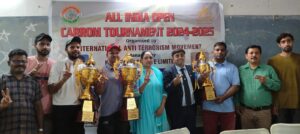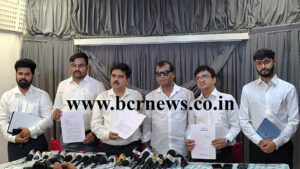
- glucose assessment tool from abbott will empower doctors to help their patients manage THEIR diabetes effectively
- software presents data in a user-friendly, visual chart, enabling productive treatment discussions
- India is THE first country GLOBALLY to launch this technology*
BCR NEWS (NEW DELHI) If you have diabetes or know of someone who does, you know the importance of living your life normally with vitality and achieving the important goal of preventing long term complications of diabetes.
Abbott today launched the professional version of its Flash Glucose Monitoring System, a transformative glucose monitoring technology for people with diabetes. The Flash Glucose Monitoring System is a glucose assessment tool that fundamentally changes how doctors can personalize their patient’s diabetes treatment plans thus allowing patients to better manage their disease.
“India now carries 20 percent of the global burden of diabetes,” said Robert Ford, senior vice president, Diabetes Care, Abbott. “There is an immense need to help people in India better manage their diabetes, enabling them to live healthier lives. Abbott’s Flash Glucose Monitoring System is designed to empower doctors in India to help their patients through rich data and actionable insights.”
Abbott′s Flash Glucose Monitoring System consists of a small, round sensor— slightly larger than a 10 rupee coin. A doctor applies the discreet, water-resistant1 and disposable sensor on the back of the upper arm of a person with diabetes. The sensor is held in place with a self-adhesive pad and remains on the back of the arm for up to 14 days, requiring no patient interaction with the sensor or finger-prick calibration.
The system continuously measures glucose in interstitial fluid through a small (5mm long, 0.4mm wide) filament that is inserted just under the skin. It records glucose levels every 15 minutes, capturing up to 1340 glucose readings over 14 days, thus giving the treating doctor comprehensive data for a complete glucose profile of their patient.
After 14 days, the person returns to the doctor’s office, where the doctor uses a Flash Glucose Monitoring reader to scan the sensor and download the glucose results that are stored in the sensor—in as quickly as five seconds. Scanning can take place while the sensor is under clothing2, making scanning more discreet and convenient.
The Importance of Visual Data
Once the reader has downloaded the glucose data from the sensor, the doctor then transfers the data from the reader into a computer. The software can generate reports that provide doctors with the Ambulatory Glucose Profile (AGP) graph, a visual snapshot, which helps them:
¾ Clearly and easily understand when sugar levels go high and low (hypoglycemic 3 or hyperglycemic 4 ) over a typical 24 hour period
¾ Identify when patient presents hypoglycemic or hyperglycemic trends
¾ Detect overnight hypoglycemia trends
¾ Identify postprandial (sugar levels after taking food) glucose spikes
This data can help doctors have more productive discussions with their patients, make more informed treatment decisions and modify treatment accordingly to suit a patient’s individual lifestyle. These reports can also be used as an information tool by people with diabetes to see the impact of food, medication, health and exercise on their blood sugar levels thus empowering the patient to taking control of their diabetes.
“India has the world’s second largest prevalence of Diabetes and a significantly high number of people having poor sugar control,” said Dr. S.K. Wangnoo, Senior Consultant Endocrinologist, Indraprastha Apollo Hospitals. “Glycemic variability is an important parameter when deciding control levels and treatment decisions. However current monitoring tools are limiting as they don’t reveal the complete picture. The revolutionary flash glucose monitoring system will help me get a complete glucose profile of my patients, thus helping me in my treatment decisions.”
“Abbott is at the forefront of healthcare innovation, helping people live healthier,” said Dilip Rajan, Country Head of Abbott’s diabetes care unit in India. “Customer insights on the shortcomings associated with current monitoring tools guided the development of the Flash Glucose Monitoring System. This technology will assist doctors manage diabetes of their patients better. We are excited that India is the first country globally to launch the professional version of the flash glucose monitoring technology.”
Diabetes in India
India’s population living with diabetes today is 65.1 million, and that number is expected to cross 100 million by 2030 5. Poor diabetes control, a factor that has been observed in the Indian population with diabetes, puts them at increased risk of health complications including nerve problems, heart diseases, retinopathy and foot ulcers 6.
The recent Abbott Sugar Survey conducted in partnership with the Association of Physicians of India 7 showed that 90% of people surveyed with uncontrolled diabetes [higher than 7 HbA1c] in India continue to perceive that they have control over their glucose levels, despite facts suggesting otherwise. Managing diabetes effectively is following a healthy meal plan, exercising regularly, taking medicines regularly as advised and monitoring glucose levels 8.
The Flash Glucose Monitoring System will be available to doctors in Mumbai, Delhi, Chennai, Bangalore, Pune and Trivandrum in the coming weeks. For further details, call the Abbott Diabetes toll-free customer care number at 0008001005780 or write to us at adc-cs.id@abbott.com.
About Abbott:
Abbott is a global healthcare company devoted to improving life through the development of products and technologies that span the breadth of healthcare. With a portfolio of leading, science-based offerings in diagnostics, medical devices, nutritionals and branded generic pharmaceuticals, Abbott serves people in more than 150 countries and employs approximately 73,000 people.
In India, Abbott has more than 14,000 employees working in manufacturing, research and development, logistics, sales and marketing and is headquartered in Mumbai.
Visit Abbott at www.abbott.com and connect with us on Twitter at @AbbottNews.
——————–
* Version managed by doctors
REFERENCES:
- Sensor is water-resistant in up to 1 metre (3 feet) of water and should not be immersed longer than 30 minutes.
- The reader can scan through clothing with a thickness of 1-4 cm
- Hypoglycemia is a condition characterized by abnormally low blood glucose (blood sugar) levels, usually less than 70 mg/dl. American Diabetes Association. Available athttp://www.diabetes.org/living-with-diabetes/treatment-and-care/blood-glucose-control/hypoglycemia-low-blood.html
- Hyperglycemia is the technical term for high blood Glucose (blood Sugar). When blood sugar values are above target, i.e Fasting Blood Glucose higher than 130 mg% and greater than 180 mg% 2 hours post meal, it is denoted as hyperglycemia Mayo Clinic. Available at http://www.mayoclinic.org/diseases-conditions/hyperglycemia/basics/tests-diagnosis/con-20034795
- International Diabetes Federation Diabetes Atlas, 6th edition 2013
- Mohan V, Shah S, Saboo B. Current glycemic status and diabetes related complications among type 2 diabetes patients in India: data from the A1chieve study. JAPI (Suppl) 201361:12–15.
- Abbott Sugar Survey: http://www.telegraphindia.com/external/display.jsp?mode=details&id=42582#.VPfrN9rrbIU
http://prod2.dam.abbott.com/en-in/documents/pdfs/media/Abbott_Sugar_Survey_Infographic_Final.pdf
- National Diabetes Educational Program available at: http://ndep.nih.gov/media/NDEP67_4Steps_4c_508.pdf







